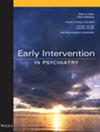Borderline Personality Disorder or First-Episode Psychosis? Challenges in Assessing Psychotic Features in Early Intervention: A Case Report
Abstract
Introduction
Adolescence is a crucial period for the onset of both borderline personality disorder (BPD) and first-episode psychosis. Although transient stress-related paranoid ideation and dissociative symptoms are one of the diagnostic criteria for BPD, determining when these psychotic features progress to early-stage schizophrenia remains unclear.
Methods
Two case studies aimed to explore the challenges in assessing and following up on psychotic features in BPD over time. Two adolescent girls aged 14 and 15 were initially diagnosed with BPD using semi-structured clinical interviews for DSM-IV personality disorder. Five years later, symptom development was explored using comprehensive diagnostic interviews.
Results
Both cases exhibited lapses in reality testing at baseline, interpreted as transient and stress-related symptoms. The first case illustrated the difficulties in distinguishing normative magical and imaginative thinking in youth from odd beliefs or bizarre fantasies and preoccupations, emphasizing the need for age-adapted and elaborate, detailed phenomenological assessment of the content, duration and frequency of these experiences and their impact on functioning. The second case demonstrated the progression of psychotic features from adolescence into early adulthood and the challenge of judging whether these features crossed the threshold to psychosis.
Conclusion
Both cases underscore the need for clinical training regarding differential diagnostics and management of psychotic features when present in early manifestations of BPD. This gap in care presents a missed opportunity for inclusion of patients in targeted early intervention programs for first-episode psychosis. We propose the implementation of a continuous monitoring strategy in BPD with psychotic features.


 求助内容:
求助内容: 应助结果提醒方式:
应助结果提醒方式:


